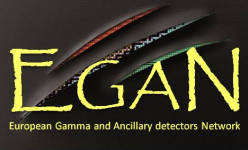Speaker
Michael Albers
(Institut für Kernphysik, Universität zu Köln)
Description
Nuclei in the neutron-rich A&asymp100; mass region are well suited for the understanding of the development of collectivity. By adding only a few neutrons to the N=50 shell closure, collective effects can quickly occur. For the Z=40 (Zr) isotopes, N=56 becomes an effective shell closure, so that 96Zr is quoted as a doubly-magic nucleus. Adding only a few neutrons more, the Zr-isotopes get strongly deformed. This behaviour indicates a shape phase transition at N=60 from spherical to deformed shapes. For the Z=38 (Sr) and Z=42 (Mo) isotopes the systematics show a similar behavior, whereas for the Z=44 (Ru) isotopes, this rapid change of the shape seems to be attenuated. The aim of our work was to investigate the behaviour of the Z=36 (Kr) isotopes in this phase transition region by determining the energies of the 2+1 states and their E2 decay transition strengths to the ground state in 94Kr (N=58) and 96Kr (N=60). Therefore, we performed two experiments at REX-ISOLDE at CERN in 2009 and 2010. We utilized the high-efficiency MINIBALL gamma-ray spectrometer to analyse the emitted gamma-rays and scattered particles after Coulomb-excitation. We will show and discuss the preliminary results. This work was supported by BMBF under Grant 06KY205I and 06KY9136I.
Primary authors
Andrey Blazhev
(Institut für Kernphysik, Universität zu Köln)
Dennis Mücher
(Physik Department E12, TU München)
Jan Jolie
(Institut für Kernphysik, Universität zu Köln)
Michael Albers
(Institut für Kernphysik, Universität zu Köln)
Nigel Warr
(Institut für Kernphysik, Universität zu Köln)
Co-authors
Collaboration Miniball
(.)
Prof.
Dave Jenkins
(Department of Physics, University of York)
Dr
Marcus Scheck
(Institut für Kernphysik, TU Darmstadt)
Dr
Marginean Nicolae
(HHNIPNE Bucharest)
Prof.
Peter Reiter
(Institut für Kernphysik, Universität zu Köln)
Prof.
Piet van Duppen
(Instituut voor Kern- en Stralingsfysica, KU Leuven)
Prof.
Robert Wadsworth
(Department of Physics, University of York)
Prof.
Thorsten Kröll
(Institut für Kernphysik, TU Darmstadt)

